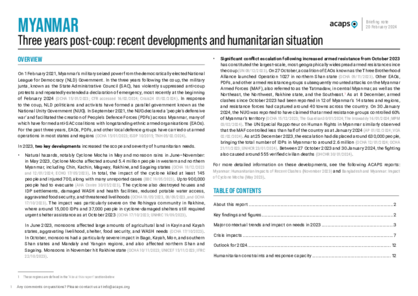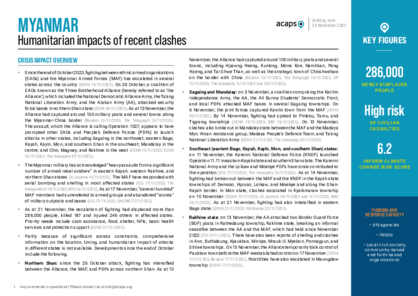Latest updates on country situation
02 April 2024
As at 25 March 2024, the resumption of armed conflict in Rakhine state since the breakdown of a ceasefire between the Arakan Army and the military junta in November 2023 had displaced nearly 157,000 people, bringing the number of IDPs in the state to around 350,000. The majority of the newly displaced are in rural areas and need shelter and essential relief items. The renewed conflict has resulted in heightened protection concerns in Rakhine, with 170 civilian deaths as at 3 March 2024 and the risk of forced conscription into military service. Armed conflict, administrative restrictions, road and waterway closures, telecommunication network interruptions, and power cuts are disrupting the supply chain and hindering the humanitarian response. As a result, Rakhine is facing food scarcity, shortages of essential items such as fuel, and increased prices of essential goods. Water scarcity is also a concern, especially for displaced people. (OCHA 03/04/2024, OCHA 03/03/2024, UNHCR 29/03/2024)
27 March 2024
As at 26 March 2024, armed conflict between the military junta and armed resistance groups since late February 2024 in Kale and Monywa townships had internally displaced 28,000 and 25,000 people, respectively. Based on past displacements, urgent needs likely include shelter, food, potable water, and NFIs. (OCHA 26/03/2024)
27 March 2024
As at 26 March 2024, armed conflict between the military junta and armed resistance groups since early March had internally displaced more than 18,000 people in ten townships of Kachin state, many of whom had taken refuge in forest areas. The displaced people urgently need food, water, and shelter materials. (OCHA 26/03/2024, KNG 24/03/2024)
19 March 2024
As at 18 March 2024, armed conflict between the military junta and armed resistance groups in Kale and Kani townships in Sagaing region had displaced 24,000 people within the month. Based on past displacements, their urgent needs likely include shelter, food, potable water, and NFIs such as blankets, hygiene kits, and jerrycans. (OCHA 19/03/2024)
19 March 2024
As at 18 March 2024, armed conflict in southeast Myanmar between the military junta and armed resistance groups had displaced 22,000 people within the month in Kayin state, southern Shan state, and Tanintharyi region. Based on past displacements, urgent needs likely include shelter, food, potable water, and NFIs. (OCHA 19/03/2024)
27 February 2024
As per media reports, raids and air strikes by the military junta’s forces in the villages of Shwebo district, Sagaing region, displaced 50,000 people from January–February 2024. The displaced need food, shelter, and winterisation support. The displacement has disrupted summer paddy cultivation, worsening the food shortage situation. (The Irrawaddy 22/02/2024, UNHCR 22/02/2024, UNHCR 03/01/2024)
27 February 2024
As at 19 February 2024, intensified armed conflict had displaced around 50,000 people in Htantabin township, Bago (East) region, within February – both internally and externally to other townships, namely Oktwin and Taungoo. The displaced need food, shelter, and healthcare support. (UNHCR 16/02/2024, UNHCR 22/02/2024, MPM 19/02/2024)
current crises
in
Myanmar
These crises have been identified through the INFORM Severity Index, a tool for measuring and comparing the severity of humanitarian crises globally.
MMR004 - Post-coup conflict
Last updated 27/03/2024
Drivers
Violence
Socio-political
Conflict
Crisis level
Country
Severity level
4.4 Very High
Access constraints
5.0
MMR001 - Country level
Last updated 27/03/2024
Drivers
Socio-political
Conflict
Violence
Crisis level
Country
Severity level
4.6 Very High
Access constraints
5.0
MMR002 - Rakhine conflict
Last updated 27/03/2024
Drivers
Conflict
Crisis level
Country
Severity level
3.9 High
Access constraints
5.0
MMR003 - Kachin and Shan conflict
Last updated 27/03/2024
Drivers
Conflict
Crisis level
Country
Severity level
3.7 High
Access constraints
4.0
REG011 - Rohingya Regional Crisis
Last updated 30/03/2024
Drivers
Crisis level
Regional
Severity level
4 High
Access constraints
5.0
Analysis products
on
Myanmar
29 February 2024
Reported attacks on healthcare: 2021–2023
29 February 2024
Evolution of IDP numbers and locations: 2021–2023
28 February 2024
Humanitarian access situation in Myanmar
Extreme access constraints persist in Myanmar. Armed conflict and security measures, including checkpoints, roadblocks, and curfews, affect humanitarian access. Violence and insecurity resulting from the conflict have internally displaced many towards remote jungles and forests, where access to aid and services is very limited.
Around 600,000 Rohingya in Rakhine state continue to be denied citizenship and have limited freedom of movement and access to livelihood opportunities, education, and healthcare. Burdensome bureaucratic processes, travel authorisation denials and delays, visa delays for humanitarians, and banking restrictions hinder the operations of humanitarian organisations in the country.
For more details, please visit our thematic page on humanitarian access.
20 February 2024
Myanmar: three years post-coup
DOCUMENT / PDF / 5 MB
The report reviews the evolution of the humanitarian situation across Myanmar in 2023 and early 2024, focusing on key contextual developments and humanitarian trends. It also highlights the response capacity and constraints and provides an outlook for humanitarian developments throughout 2024.
23 November 2023
Myanmar: humanitarian impacts of recent clashes
DOCUMENT / PDF / 8 MB
Since the end of October 2023, fighting between ethnic armed organisations (EAOs) and the Myanmar Armed Forces (MAF) has escalated in several states across the country. On 26 October, a coalition of EAOs known as the Three Brotherhood Alliance, attacked security force bases in northern Shan state.



